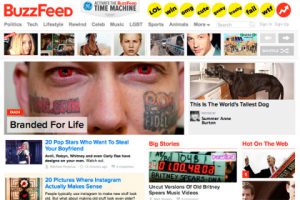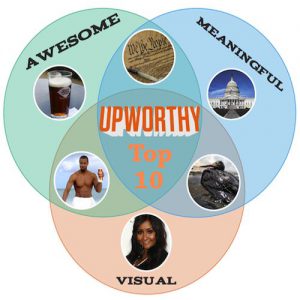Some newspapers and magazines have profitable longterm strategies; and some might even continue to resemble the publications they are today, whether on paper or digitally. But not many. Weighed down by historic costs, many publishers have been beached by the changing digital appetites of readers and advertisers who have found better ways to spend their time and money…

Publishers everywhere are paying the price for getting hooked on advertising revenues which corrupted the vital relationship with their primary customers, the readers. They effectively “bribed” increasing numbers of non-core readers with low cover prices, heavy promotion and all manner of freebies – in order to secure more advertising. And few newspaper editors even considered the possibility that “readers” had been attracted as much by high-revenue classifieds as by high-cost journalism. And similarly-hooked magazines woke up to discover their content sprouting all over the web – for free. Millions of readers and advertisers suddenly had somewhere else to go.
The implosion of that 20th century reader-advertiser business model has been lamented in the five years since newspaper ads peaked in most developed economies – and then abruptly fell by at least 50%. That collapse has been accompanied by eulogies for the fine journalism that would theoretically be sacrificed if readers and/or other benefactors could not be persuaded to pay for it.
The fears sound logical enough from a pre-internet world of news monopolies. But, for all the pain suffered by newspapers and magazines, online stats show that the consumption of news in all its forms is now growing rapidly. And two major trends, which threaten the survival of so much traditional media, will actually increase the diversity of journalistic content:
- Online consumers increasingly expect either to get free access and put up with the banners, native advertising and data targeting. Or to pay for the service. Not both. This is clear in music streaming and pay movie channels, and we should expect email providers to offer paid-for services that will insulate users from ads. The profitable growth of free newspapers and magazines is another manifestation of this trend. But many publishers still depend on revenue both from readers and advertisers.
- High-quality journalism is increasingly finding its place on the web. Top-rated journalists, especially in the US, are defecting from traditional media.

The way that digital services are set to squeeze the life out of increasing numbers of newspapers is underlined by last month’s departure of Ezra Klein from the Washington Post. He is the 29-year-old creator of the Post’s best-read Wonkblog which covers healthcare and budget policy. He has been variously named as one of the 50 most powerful people in Washington, Blogger of the Year and Best Online Commentator. In January, just five months after the Washington Post was acquired by Amazon’s Jeff Bezos, Klein announced he would be leaving with colleagues to start an unnamed new venture at Vox Media, online home of sports site SB Nation and fast-growing tech service The Verge.
Start of ‘new journalism’
Klein says: “We are just at the beginning of how journalism should be done on the web. We really wanted to build something from the ground up that helps people understand the news better. We are not just trying to scale Wonkblog, we want to improve the technology of news, and Vox has a vision of how to solve some of that. We want to think really hard about how to connect not just new information, but to bring it together with important contextual information to create a more thorough source and place to understand the world.”
He is a real star signing for Vox but is just one of a series of celebrated journalists who have defected from the Wall Street Journal and New York Times to digital startups in recent months. Most people expect BuzzFeed’s new UK edition (now with some 16m monthly uniques – 60% up in its first few months) to recruit political columnists to match its approach in the US: the site famous for slide shows like “16 Horses That Look Like Miley Cyrus” has a team of serious investigative journalists.
It’s a long way from 2011, when the little-known site broke the US election news that former Presidential candidate John McCain was endorsing Presidential challenger Mitt Romney. Readers and commentators alike asked “What is a BuzzFeed?”
That was the first political scoop for BuzzFeed and for Ben Smith, its new editor-in-chief, a star recruit from the US site Politico. Today, the fast-growing “news-you-can-share” is an amazing mix of genuine political scoops, viral videos and easy-to-digest lists (“19 struggles you’ll only understand if your parents have Facebook”).

It is now head-to-head globally with the UK-based Mail Online’s 150m monthly uniques. But only the US-owned operation is (already) soundly profitable, due to its success with native advertising (indeed, it almost invented the category).
BuzzFeed’s European sales chief emphasises the money-spinning mind-set of a company built on content marketing and native ads: “We think that banner advertising – producing billions of ads that nobody looks at, clicks on, or enjoys – will be abandoned. I think that pretty much every media house underestimates the amount of work they need to do to rebuild their ad offering. They have a long journey ahead of them and think the solution is hiring two or three people. We have 50 people globally who work on creating content for brands – content creation, not selling or optimising – and we are looking to build the best advertising team in the country to do the best social campaigns in the world.”
That strategy is a growing nightmare for newspapers and magazines because:
- Their traditional display advertising model cannot transfer to online or mobile; and native advertising is a challenge to the price of display ads and the skills of the teams which sell them.
- Many newspaper and magazine web sites have substantial online audiences – but no way to monetise them. Paywalls are seldom the answer.
- That growth in online audiences helps to accelerate the decline in hard copy sales, advertising revenue and profit: online can seem bad for current business.
- These challenges to profitability and long-term growth can be exacerbated by publishers trying to sell advertising simultaneously across hard copy and digital platforms, leading them to combine readership/ audience figures. The resulting mish-mash may be flawed. But, worse, circulation auditors often require the digital edition to be a near-clone of the hard copy “original”. Over time, this will become an obvious handicap in the video-rich, interactive competition for digital audiences: How can traditional media really compete long-term with digital insurgents simply by cloning hard copy products – and choosing not to exploit all the digital possibilities? But that’s the price publishers are paying in order to shore up hard copy advertising sales. Short-term or what?
Digital without conflict
Pure-play digital news services have no such conflicts as they build audiences and revenues – and consolidate online’s role as the default source for increasing numbers of consumers. That expansion has been spurred by social media like BuzzFeed whose success is based on the sharing of content and advertising, largely via Facebook. And, now, other sharing media channels are joining the race.

Upworthy, which has generated an astonishing 88m monthly uniques in its two years since launch, has charged into the media landscape. Founders, digital entrepreneurs Eli Pariser and Peter Koechley, say they’re focused on “meaningful” topics, from body image issues caused by Barbie dolls to the plight of torture victims. Fast Company magazine called the site “soulful BuzzFeed”. Others have called it “serious news for a spreadable age”.
Pariser and Koechley were encouraged in November 2011 when the gay marriage debate was raging in the US. There was a remarkable video of an earnest young man from Iowa talking about being raised by two women parents, which got 700,000 hits on YouTube. The web story under the headline “Two lesbians raised a baby and this is what they got” attracted 17 million views in five days.
To emphasise the socio-political distinction with BuzzFeed, Pariser says: “Upworthy is a mission-driven business. We try to get stuff that matters into the information stream.” His team comprises journalists and leaders from the not-for-profit sector.
Business Insider has described Upworthy as “the fastest growing media company of all time”. It’s a comment that says as much about the five-year-old business and technology news service itself. The New York-based site, which has been profitable for the past three years, was founded by Kevin Ryan, former CEO of Double-Click and founder of online retailer Gilt Groupe. It provides authoritative analysis of business news – and aggregated stories – from around the web, with a newsroom staff of 55, has a turnover of almost $20m, more than 20m unique monthly visitors (doubled in a year) – and Jeff Bezos is a leading investor.
This is a distinctly 21st century digital media channel. A slideshow of “the sexiest CEOs alive” earned 2m views but so did 20,000-word CEO profiles of Yahoo’s Marissa Mayer and AOL’s Tim Armstrong. As if to define the site’s heady blend of highbrow and lowbrow, the team includes recruits from Gawker, AdWeek and daily newspapers. It is primarily funded by advertising but also has a subscription research service on the mobile industry, and the glittering annual conference Ignition: Future of Digital.

Business Insider is the voice of the disruptive technologies and, by definition, of the new media players – like itself. Its larger-than-life CEO is the bullish dotcom commentator Henry Blodget, also the host of the Yahoo Daily Ticker finance show. In a previous life, he worked on Wall Street before being fined a whopping $4m and barred by the SEC in a fraud case. He is bullish about digital media insurgents: “Digital journalism is as different from print and TV journalism as print and TV are from each other. Few people expect great print news organizations to also win in TV. Similarly, few should expect great TV or print organizations to win in digital. The news-gathering, storytelling and distribution approaches are just very different.”
Tech business reporter Jessica Lessin agrees. She quit the Wall Street Journal six months ago to launch The Information with five journalists. It is a subscription-only technology and business news service that costs $39 per month or $399 a year and has no free content – and no advertising. The “hard” paid-for strategy surprised observers, but Lessin says: “People talk about this type of paywall being good or bad, but it really depends on the content. The only type of content you’re going to pay that much money for is content that helps you in your business. All the different paywall experiences are very different because the content is different and the market they are going after is different.”
Why not take advertising? “I really don’t think the ad business model is aligned with our mission. Any publication that makes a meaningful amount of money through advertising ends up writing stories that generate a lot of traffic to generate a lot of ad dollars. Publications wrestle with that editorial decision. The ‘bar’ for each of our articles is: “is this worth paying for?”

Another sign of the maturing of web journalism is First Look Media, the “public service”, not-for-profit journalism venture recently launched by the US-based, former reporter of The Guardian Glenn Greenwald and eBay founder Pierre Omidyar. The Intercept, launched this week, is said to be the first in a series of single-topic online ‘publications’ from First Look. It is focused on Edward Snowden’s NSA leaks.
Omidyar and First Look editorial advisor Eric Bates (former executive editor of Rolling Stone), say the ‘magazine’ is being launched as a reaction to the “dramatic escalation in the threats against journalists reporting the NSA story.” Greenwald’s introductory email said: “As soon as we resolved to build The Intercept, we set out to recruit many of the journalists whose work we have long respected and admired: those who have a proven track record of breaking boundaries, taking risks, and producing innovative, rigorous journalism. We have assembled a team of experienced and independent journalists and editors. Our central mission is to hold the most powerful governmental and corporate factions accountable and, to do so, we will report on a wide and varied range of issues. A primary function of The Intercept is to insist upon, and defend, our press freedoms from those who wish to infringe them… essential reporting in the public interest and with a commitment to the ideal that a truly free and independent press is a vital component of any healthy democratic society.”
Growth of non-profits
More not-for-profit journalism is on the way from veteran New York Times editor Bill Keller who is launching the Marshall Project with backing from former hedge fund manager Neil Barsky, who was also once a Wall Street Journal reporter. Barsky says: “Our goal is to create a first-class news organization that will spark a national conversation about the troubled US criminal justice system.” The project, which will have promised annual funding of some $5m, is recruiting a team of 20 journalists. They are seeking to emulate ProPublica, the six-year-old, not-for-profit investigative news site, founded by journalists from the New York Times and Wall Street Journal. Under Keller, the New York Times and ProPublica had collaborated on a Pullitzer-winning investigation into hospital deaths during Hurricane Katrina.
Gawker Media, the 10-year-old celebrity gossip site and blog network founded by New York-based Brit Nick Denton, typically puts the Marshall Project into context: “And what does this “say” about “the media?” It says this: the glory days are over for the old guard. The fact that a man who spent decades assiduously climbing to the top of an institution as hallowed and fusty as the New York Times would drop a cushy perch as a columnist to go join a startup is a great flashing sign that reads, “Newspapers are the past.” Bill Keller has now willingly left what were until very recently considered the two most desirable jobs in journalism: editor of the New York Times, and columnist for the New York Times…The media world has grown up, up and away from its old gatekeepers. That’s a good thing for everyone.”

And, then there’s the world’s best-known digital-only news service, the Huffington Post, launched in 2005 by Arianna Huffington. In the three years since acquisition by AOL, its audience has more than tripled from 25m to almost 90m. It has branched out to cover lifestyle, entertainment, business and technology, on 60 vertical sites and also HuffPost Live, “the first cable channel on the web”. It has expanded to France (a joint venture with Le Monde), Japan and Africa, and plans to be in Brazil, India and “other countries that collectively generate 50% of the world’s GDP” by the end of this year.
But HuffPost is not yet profitable and will lose an estimated $6m on a turnover of $100m in 2014. That’s a long way from AOL’s post-acquisition bravado which justified its $315m investment (6 x 2011 revenues) with profit forecasts of $66m for 2013. Now, they expect the first profits in 2015. But it is clear that this largest of all digital-only news services is becoming a substantial business for the longterm and with an international profile ahead of most traditional media groups. It is leader of the pack.
Digital diversity
The rising success of pure-play digital media is made more significant by their increasing diversity. It does not matter whether today’s high-flying operators survive because – if not – their imitators will. These services and the host of others being developed around the world are effectively closing what had been a ‘ journalism gap’ between hard copy and digital.
Increasingly, there will be no style or format of journalism available in hard copy that is not widely available online. That’s a big change from a world where hard copy has (sort of) dominated long-form, analytical journalism while online seemed to be all hot news and ephemera. With or without the non-profit patronage of crusading journalism, money is no longer the obstacle. Newspaper groups now know some of their best journalistic talent is preparing to defect to the web – along with the profits.
With the price of web advertising dropping remorselessly even while audiences boom, we are seeing the emergence of a long-lasting commercial market for digital media. The explosion of new, well-funded sites ought to send a shudder through the ranks of traditional media for at least four reasons:
- Increasing numbers of people are learning to depend for their news land information on digital-only sources. The traffic is only going one way.
- Digital-only businesses understand big data and they will increasingly torment media groups whose digital ambitions are compromised by their hard copy legacy. The conflicts will intensify with the rapid expansion of native and addressable advertising.
- The digital natives know how to make profits from news – unlike most newspapers who lost their touch along with the classified ads. The commoditisation of advertising is piling the pressure on the relatively high-cost operations of traditional groups. Digital realities and the growth of advertising exchanges denies legacy groups the scale economies that once made them rich and powerful.
- Most traditional consumer media should de-merge (or separately manage) their digital services. They should use their still-powerful media brands to help them build new businesses to compete with the agile natives who, single-mindedly, understand the online appetites of digital audiences. Separation, incidentally, could also help focused management to maximise print profits and, perhaps, even prolong the life of traditional brands (as Harvard professor Clark Gilbert is proving in Salt Lake City – see Flashes & Flames link below). Otherwise, publishers will lose more of the journalistic talent that is so vital to the distinctiveness and value of all media. They must find ways of retaining – and monetising – their famous brands, original content, and audiences in a digital world which threatens to marginalise them.
Traditional news groups must decide whether to compete seriously with digital natives – or not. They might well be able to extract continuing profits from hard copy for a decade or more. But those profits are declining, while online is growing rapidly. Most (but, admittedly, not all) traditional groups must change radically in order to compete digitally. It’s not a question of whether to operate web sites, tablet editions, paywalls or free services. It’s a matter of building media businesses that make sense, with “new” skills, resources and costs that are competitive with the digital natives. For daily newspapers, in particular, it’s make-your-mind-up time.
The clock is ticking.
Digital-print separation: How Harvard professor is reinventing traditional media




